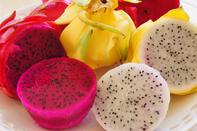What is Dragon Fruit?
Dragon fruit is a tropical fruit of the climbing cacti (Cactaceae) family. It is also known as pitaya or strawberry pear and is a native species of Mexico, Central America and South America.

This climbing vine-like cactus, with aerial roots, produces huge scaly oval fruits weighing between 150 and 600 g and range from reddish-pink to yellow in colour. In the wild, it is supported by trees, and has become an invasive species in many countries, including some areas in South Africa. In farming systems, a trellising system is used to allow for extended growth and easier harvesting.
Dragon fruit is mainly eaten fresh and is best served chilled. The thick skins are easily peeled to reveal white or pink to red flesh, dotted with tiny black seeds.
Varieties of Dragon Fruit
The skin of dragon fruit can range from pink or yellow, the flesh colour can be white, pale pink to bright pink or deep red with black seeds, similar to that of kiwi fruit.
It was always assumed that the flavour of dragon fruit is often associated with the colour of the flesh. White flesh has a milder taste while cultivars with pink or red flesh are often found to be sweeter and juicier. With the development of better cultivars, this measure cannot be reliably used anymore.
There are three most commonly farmed varieties of dragon fruit; pink-red skin with red flesh, the rarer yellow-skinned dragon fruit with white flesh and pink-red dragon fruit with white flesh.
Currently (2019) two main varieties of dragon fruit are cultivated in South Africa Hylocereus undatus has white flesh and Hylocereus costaricensis has red flesh. Both these species have pink-red skins, but the sweeter pink-fleshed Hylocereus costaricensis has a higher sugar level and is more popular.
The yellow dragon fruit Hylocereus megalanthus is a winter-flowering species. It is smaller and grows slower than the other varieties and is more sensitive to pests and diseases. It is sweeter than the red-skinned varieties. South Africa’s climate makes the yellow dragon fruit not suitable for local production.
New cultivars from South America and some developments in California, are being planted in South Africa to replace ‘traditional’ dragon fruit cultivars in South Africa with sweeter cultivars.
Certain varieties of dragon fruit like the ‘Ruby Red’ in Indonesia bears fruit from January to December. Conditions in South Africa, however, are not suitable for year-round production and this variety is only harvested during the summer months.
By Marinda Louw